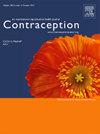What do Australian contraceptive users say about their experience of having an intrauterine device inserted? Findings from an online, qualitative survey
IF 2.3
2区 医学
Q1 OBSTETRICS & GYNECOLOGY
引用次数: 0
Abstract
Objectives
We sought to explore contraceptive users’ experiences of the intrauterine device (IUD) insertion in Australia.
Study design
We conducted an online qualitative survey with people in Australia, aged 18–45, who had undergone IUD insertion in the last 2 years. We recruited participants using online advertisements on social media and via researcher networks and inductively analysed the data.
Results
Of a total 294 recorded responses to our online survey, we included 175 based on completion of selected questions for analysis. Participants’ responses to questions regarding their overall feelings toward their experience of IUD insertion varied greatly. Here, we report on three key themes: preparedness for the procedure, the role of staff and providers, and the role of the non-clinical support person. Those who described being poorly prepared for the pain often reported feeling ‘shocked’ by the experience. Participants reported that support people fostered a sense of safety and served as advocates. Those reporting positive experiences with insertion typically described care that aligned with patient-centered principles.
Conclusions
Healthcare providers who insert IUDs should follow clinical guidelines that include guidance on preventing pain and preparing patients for potential pain. Providers can use patient-centered practice to improve patients' experiences of IUD insertion.
Implications
These results can be used to improve patient experience of IUD insertion. This work highlights important areas in clinical guidelines requiring review.
澳大利亚的避孕药具使用者如何评价他们植入宫内节育器的经历?来自一项在线定性调查的结果。
目的:我们试图探讨在澳大利亚避孕使用者的经验宫内节育器插入。方法:我们对年龄在18-45岁的澳大利亚人进行了一项在线定性调查,这些人在过去2年内接受了宫内节育器植入。我们通过社交媒体和研究者网络上的在线广告招募参与者,并对数据进行归纳分析。结果:在我们在线调查的总共294个记录回复中,我们根据所选问题的完成情况纳入了175个用于分析。参与者对关于他们对宫内节育器植入经历的总体感受的问题的回答差异很大。在这里,我们报告了3个关键主题:手术准备,工作人员和提供者的作用,以及非临床支持人员的作用。那些对疼痛准备不足的人经常被这种经历“震惊”。参与者报告说,支持人员培养了一种安全感,并发挥了倡导者的作用。那些报告插入积极经验的人通常描述了与以患者为中心的原则相一致的护理。结论:植入宫内节育器的医疗保健提供者应遵循临床指南,包括预防疼痛和为患者做好潜在疼痛准备的指导。提供者可以采用以患者为中心的做法来改善患者对宫内节育器插入的体验。
本文章由计算机程序翻译,如有差异,请以英文原文为准。
求助全文
约1分钟内获得全文
求助全文
来源期刊

Contraception
医学-妇产科学
CiteScore
4.70
自引率
17.20%
发文量
211
审稿时长
69 days
期刊介绍:
Contraception has an open access mirror journal Contraception: X, sharing the same aims and scope, editorial team, submission system and rigorous peer review.
The journal Contraception wishes to advance reproductive health through the rapid publication of the best and most interesting new scholarship regarding contraception and related fields such as abortion. The journal welcomes manuscripts from investigators working in the laboratory, clinical and social sciences, as well as public health and health professions education.
 求助内容:
求助内容: 应助结果提醒方式:
应助结果提醒方式:


